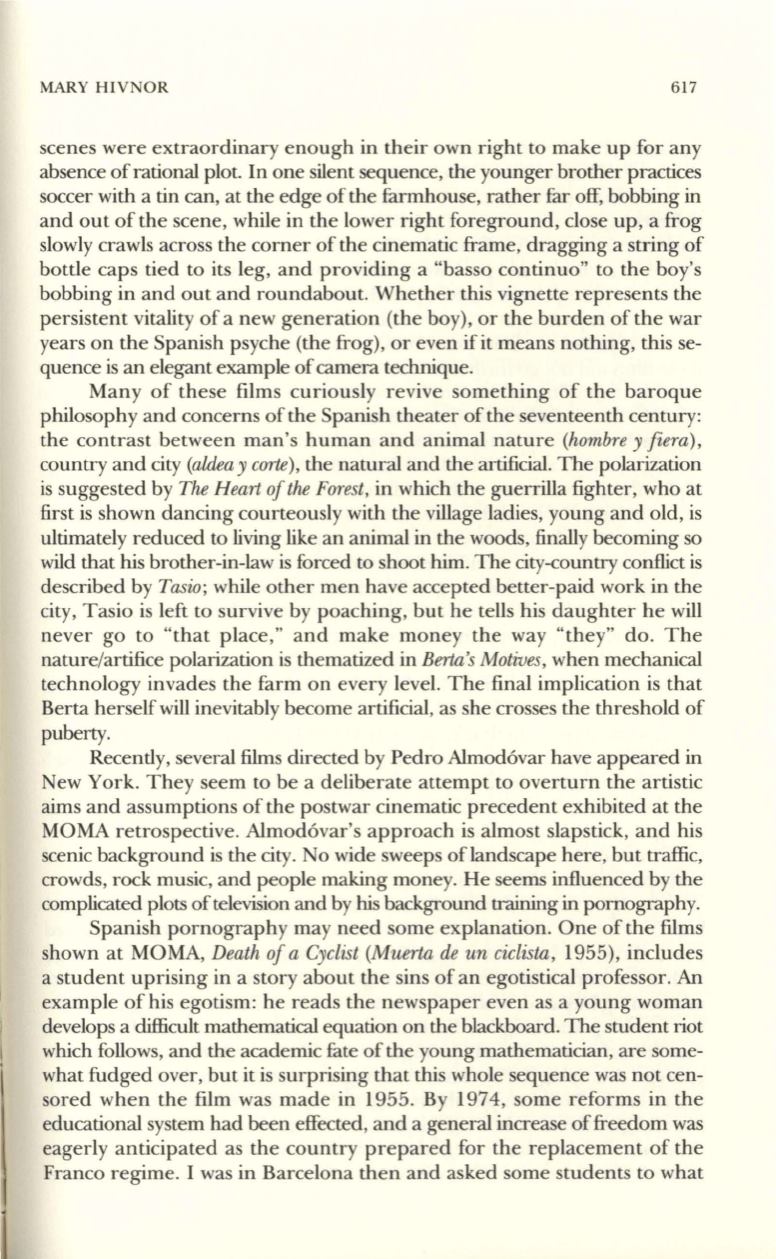
MARY H1VNOR
617
scenes were extraordinary enough in their own right to make up for any
absence of rational plot. In one silent sequence, the younger brother practices
soccer with a tin can, at the edge of the farmhouse, rather far off, bobbing in
and out of the scene, while in the lower right foreground, close up, a frog
slowly crawls across the corner of the cinematic frame, dragging a string of
bottle caps tied to its leg, and providing a "basso continuo" to the boy's
bobbing in and out and roundabout. Whether this vignette represents the
persistent vitality of a new generation (the boy), or the burden of the war
years on the Spanish psyche (the frog), or even if it means nothing, this se–
quence is an elegant example ofcamera technique.
Many of these films curiously revive something of the baroque
philosophy and concerns of the Spanish theater of the seventeenth century:
the contrast between man's human and animal nature
(hombre y fiera)
,
country and city
(aldea y corte),
the natural and the artificial. The polarization
is suggested by
The Heart of the Forest,
in which the guerrilla fighter, who at
first is shown dancing courteously with the village ladies, young and old, is
ultimately reduced to living like an animal in the woods, finally becoming so
wild that his brother-in-law is forced to shoot him. The city-country conflict is
described by
Tasio;
while other men have accepted better-paid work in the
city, Tasio is left to survive by poaching, but he tells his daughter he will
never go to "that place," and make money the way "they" do. The
nature/artifice polarization is thematized in
Berta's Motives,
when mechanical
technology invades the farm on every level. The final implication is that
Berta herself will inevitably become artificial, as she crosses the threshold of
puberty.
Recently, several films directed by Pedro Almodovar have appeared in
New York. They seem to be a deliberate attempt to overturn the artistic
aims and assumptions of the postwar cinematic precedent exhibited at the
MOMA retrospective. Almodovar's approach is almost slapstick, and his
scenic background is the city. No wide sweeps oflandscape here, but traffic,
crowds, rock music, and people making money. He seems influenced by the
complicated plots of television and by his background training in pornography.
Spanish pornography may need some explanation. One of the ftIms
shown at MOMA,
Death of a Cyclist (Muerta de un ciclista,
1955), includes
a student uprising in a story about the sins of an egotistical professor.
An
example of his egotism: he reads the newspaper even as a young woman
develops a difficult mathematical equation on the blackboard. The student riot
which follows, and the academic fate of the young mathematician, are some–
what fudged over, but it is surprising that this whole sequence was not cen–
sored when the film was made in 1955. By 1974, some reforms in the
educational system had been effected, and a general increase of freedom was
eagerly anticipated as the country prepared for the replacement of the
Franco regime. I was in Barcelona then and asked some students to what


